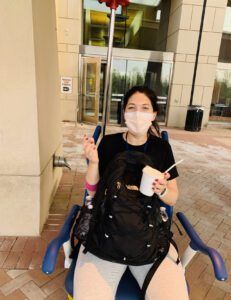Before you read on, make sure to check out Part 1 of Tracy’s story. In Part 1, Tracy discusses the symptoms that led her to pursue a diagnosis and the multi-year diagnostic odyssey. Today, we dive deeper into what mastocytosis is, as well as some of the research that she has partaken in at the NIH.
What is Systemic Mastocytosis?
Systemic mastocytosis is a rare blood disorder characterized by an excess amount of mast cells, a type of white blood cell that plays a vital role in the immune system’s chemical response to bacteria, infections, and other environmental threats. Mast cells live in every organ of a person’s body and are responsible for releasing mediators like histamine, cytokines, and leukotrienes during an allergic response. Says Tracy:
“Systemic mastocytosis is caused by a genetic mutation (KIT) occurring during the gestation period of a mother’s pregnancy. It can be triggered or ‘turned on’ at any time across a patient’s lifespan. Because people with systemic mastocytosis have too many mast cells, our bodies are in a constant state of anaphylaxis. My condition is triggered during exercise, showers, too much time in the sun, or even the friction of clothing. In short, I am biologically allergic to experiencing any change in temperature.”
Others may be triggered by alcohol, spicy food, or even certain types of medication. There are five different classifications of mastocytosis and disease progression. Some people are born with cutaneous mastocytosis, which is limited to the skin and goes away in childhood; others are diagnosed in adulthood and have a systemic, long-lasting form. Symptoms related to systemic mastocytosis can, but do not always, include:
- Enlarged spleen, liver, and lymph nodes
- Extreme fatigue
- Anemia (low red blood cell count)
- Bone and muscle pain
- Nausea and vomiting
- Abdominal pain and diarrhea
- Flushing, itching, and/or hives
- Urticaria pigmentosa
- Gastroesophageal reflux
- Shortness of breath
Treatment options for systemic mastocytosis may include antihistamines, bone marrow transplant, or chemotherapy. Currently, there is no cure.
Working with the NIH
After applying and being accepted to the NIAID, Tracy decided to get involved in research. In particular, she enrolled in three scientific research studies: a full genomic sequence, a natural history study, and a Phase 2 double-blind placebo study to evaluate a biologic treatment. Getting involved with scientific research was something that Tracy thought long and hard about. Her entrance into the research sphere was marked with questions that ran through her head relentlessly:
“What if, down the road, all of this testing, imaging, and drug trialing causes more harm than help? What if I have an adverse reaction, or my disease progresses, or I go through all of this and am just on the placebo?”

But despite these questions, and despite her self-attribution as “not a risk taker,” her decision to participate in research felt effortless and logical. She explains:
“I believe that every person inherently wants to live with purpose and intention. We all want to leave a legacy or a tiny footprint in shaping the future. No matter how or when it is my time to go, I know that I will have lived a fruitful life if I contributed to scientific advancement in this disease. My contribution will live in the NIH Library of Science indefinitely. It will live in the fabrics of genetics research, in medical journals, and in the patients and families who become the beneficiaries of this investment.
As an educator, there is nowhere more powerful to contribute to life than in the study and advancement of education and science. No matter the risk that comes with it now or how it will play out in the future, my decisions around this are about something bigger than myself and because of that it is a choice I will never ever regret.”
Expressing Gratitude
Tracy also feels grateful to be under the care of the world’s leading research hospital. Sometimes, it seems like a miracle that everything aligned to make it all possible. Systemic mastocytosis needed to be chosen for priority study. A study had to be available—with research funding—when Tracy was living just 25 miles away. Only 10,000 patients per year are seen by the research experts at NIH. Her nurse practitioner identified a rare and understudied disease, and the onset was when Tracy was young. She says:
“Imagine if I had my annual appointment with someone else. Would they have even caught it? Most people diagnosed are twice my age, which made this process more isolating at times. But what if that element that makes me so scientifically interesting is that I am an otherwise exceptionally healthy individual? Many mastocytosis patients spend years or even decades being passed around to doctors with no leads. It’s not uncommon for people to fly across an ocean or drive across state lines just to find a physician with knowledge of the disease. Others sacrifice time, money, and a whole lot of frustration being misdiagnosed. To be where I am today is humbling.”

Tracy is also thankful that, because of the NIH, she has not had to pay for her bloodwork, liver biopsy, MRIs, Dexascan, endoscopy, bone marrow biopsies, or other needs. It helps her to stay positive in moments where everything can seem a bit demoralizing. Tracy says:
“I could find a million inconveniences that come with this condition. But I will never lose gratitude for the financial burden that I have been freed of. There is no greater blessing – and if silver linings could be platinum – this would be it.”
At the same time, Tracy recognizes that NIH is not where she will be forever. But she knows that her time at the NIH and NIAID will give her the expertise and knowledge to maintain a high standard of care through the rest of her life. She knows that her doctors at home will have the tools and intel needed to carry out her care plan. And not a day goes by where she doesn’t appreciate this opportunity.
Join us in Part 3, where Tracy discusses living and managing mastocytosis, sharing her story on Daretoberare.me, and advice for others on their rare journey.


